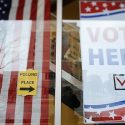2015 Gladfelter Awards for Government Innovation announced
The La Follette School of Public Affairs at the University of Wisconsin–Madison has announced the 2015 winners of the Lloyd D. Gladfelter Award for Government Innovation, which recognizes nonelected municipal, county, state, or federal employees who, through their careers or through a specific innovation, have helped solve a problem for Wisconsin residents and improved public service in the state.
Nominations are judged on their creativity, feasibility and potential impact. This year $7,500 will be awarded for four projects.
“We were thrilled to have so many creative and inspiring applications for the Lloyd D. Gladfelter Award for Government Innovation,” says Professor Susan Yackee, director of the school. “We received more nominations than ever before, and it was extremely hard to narrow this down to a few winners. As evidenced by these nominations, the state and our citizens are already the winners due to these ‘above and beyond’ efforts by our public employees.”
Gladfelter was a 1926 UW alumnus who spent his career at the Milwaukee Journal as a government reporter. The winners will be honored on Feb. 4, 2016, at the La Follette School of Public Affairs Alumni and Friends reception in Madison.
The award winners and their projects are:
First Place $4,000 — Tammy Conforti and the Kenosha Dream Playground Project (KDPP)
Tammy Conforti, a lifelong resident of Kenosha, has worked for the Kenosha Unified School District as an Early Childhood Special Education teaching assistant for the past 16 years. In June of 2012 she spearheaded the Kenosha Dream Playground Project, a grassroots initiative to build an inclusive, accessible playground for people of all abilities.
Conforti’s goals were simple but powerful: first, educate and advocate for the importance of inclusive accessible play; second, to raise $1 million for the uniquely designed playground; and third, to plan and execute a community build by organizing over 3,000 volunteers. Through her relentless determination, she garnered unanimous local government support to create a public-private partnership and began raising funds.
Conforti engaged volunteers from the community and formed her “Dream Team.” She collaborated with numerous schools, churches, day cares, restaurants, police, sheriff and fire departments as well as local service organizations that eagerly conducted independent fundraisers. She began a corporate capital campaign that achieved her goal of raising $1 million in less than three years.
A wheelchair-accessible swing and a wheelchair-accessible merry-go-round were two of the top priorities on “Tammy’s must have it” equipment list. To ensure that the playground was accessible to everyone, she made sure that the 15,000-sq. ft. playground was surrounded by poured-in-place rubber flooring. She engaged over 3,000 volunteers from various walks of life to work together to build the Dream Playground.
Impact: This fall, Conforti’s dream became a reality and as a result, children will no longer be left sitting on the sidelines watching others play. When she is asked about the project’s success she humbly responds by saying, “The community built the playground and the playground built the community.”
Second Place $2,000 — Jared Knowles and the Dropout Early Warning System (DEWS)
Approximately 6,000 students drop out of Wisconsin public schools each year. While most of these students drop out in the 11th or 12th grades, it is during the middle grades that they typically exhibit characteristics connected to dropping out. Predicting which of these students are at a higher risk of dropping out of school later on can lead to critical interventions that prevent students from actually dropping out. This is why the Dropout Early Warning System (DEWS) was created.
Jared Knowles, a research analyst with the Wisconsin Department of Public Instruction, played a central role in the development of DEWS, which is available to every public school in the state of Wisconsin. Through DEWS, schools identify students in grades 6-9 who are most at risk and educators plan interventions and additional services before the critical transition to high school. It identifies over 6 in 10 students who will eventually drop out or graduate late.
DEWS provides a red flag to schools early enough to make data-based decisions, provide interventions, and focus available resources. Like a “check engine” light on a car, it signals that a closer look and perhaps service are needed. DEWS reports are available to approximately 1,000 schools in the state enrolling a student in grades 6-9. Schools combine the DEWS risk score with local data (such as current grades, behavior, attendance and test data) to prioritize those most in need of support.
Third Place $1,000 — Sarah Turner and the Teen Driving Summit in Barron County
The death of a young man in a texting-and-driving crash resulted in a countywide Teen Driving Summit for all seven high schools in Barron County. More than 400 students attended the event. Students heard from speakers and tried various simulators and activities, and were trained as advocates and given “tool kits” to take safe driving messages and activities back to their respective schools and communities.
The summit spawned partnerships between the Crossroads Teen Driving Program, Sheriff Chris Fitzgerald, Lakeview Medical Center (LMC) and the Safe & Stable Families Coalition. From these partnerships, a Safe Teen Driving Team was created. Together, they purchased a Virtual Interactive Driver simulator to help decrease distracted and impaired driving.
The simulator includes two programs: One Simple Decision and Boating Skills. It’s designed to prevent destructive driving behaviors, including texting and drinking and driving. The simulator has been used in multiple settings including the county fair, senior centers, schools and DNR boating safety events. The effort has other real results as well: The county’s Youth Risk Behavior Surveillance Survey showed a more than 10 percent decrease in 16-, 17- and 18-year-olds texting, emailing or talking while driving in the past 30 days.
Fourth Place $500 — Diane Rondini Harness and the StEPP committee of Matthew Giesfeldt, Richard Jones, Gina Pruski, Eileen Fredericks, Puck Tsai, Catherine Dorl, and Evan Nordgren for the Student Expulsion and Prevention Project (StEPP)
The Student Expulsion Prevention Project (StEPP) was set up to address a glaring need to guide and assist students facing expulsion hearings. By providing pro bono attorneys, StEPP ensures children involved in expulsion hearings have an advocate looking after their welfare and rights. In the absence of StEPP, children typically would go unrepresented at expulsion hearings and, as a result, potentially face lifelong consequences stemming from barriers to education and future employment. This is sometimes described as the school-to-prison pipeline, since children who are suspended or expelled are at greater risk of becoming truants, dropping out of school and becoming involved in the justice system.
StEPP is a partnership and collaboration relying on volunteer attorneys. The State Public Defender’s Office has set up a mechanism for students facing expulsion hearings to request an attorney. StEPP is a team effort to ensure students are receiving legal representation in such hearings.
To get the program up and running, a committee was formed consisting of Matthew Giesfeldt, Richard Jones, Eileen Fredericks, Devon Lee, Gina Pruski, Puck Tsai, Evan Nordgren, Catherine Dorl and Diane Rondini-Harness. Each attorney brought their own expertise in training, juvenile law and expulsion law, and collectively developed basic guiding principles for representation.
The guiding principles for StEPP include: every student has a story that provides context for their actions; and it is the attorney’s duty to tell that story in a culturally-humble way while protecting the student’s rights to a fair process. Most importantly, remaining in school is best for the student and the entire community.
A pilot project has been operating in the Madison Metropolitan School District since Feb. 1, 2015. The need in Madison is apparent: during the 2012-13 school year, 146 students were recommended for expulsion with 28 involved in an expulsion hearing, yet only two students were represented by an attorney.
As a result, StEPP has changed the statistics: Last semester StEPP represented six students facing expulsion in MMSD. Of these students, 83 percent were facing expulsion for possession/distribution of small amounts of marijuana. The same percentage — 83 percent — represents the portion who were male as well as the percentage who were children of color. Additional statistics surrounding the students reveal that half had expulsion hearings, and half were expelled. But most importantly, all of the students were out of school for less time than originally sought.




